-
Engine5.2L V10
-
Power620 HP / 420 LB-FT
-
Transmission6-Speed Sequential
-
DrivetrainRear-Wheel Drive
-
Engine PlacementMid
-
Curb Weight2,800 LBS (est.)
-
Seating1
-
Base Price$325,000
Pull a run-of-the-mill Lamborghini Huracán LP 610-4 off the Sant'Agata Bolognese assembly line, and you'll get a fearsome piece of machinery that can hit 60 miles per hour in as little as 2.5 seconds and reach a terminal velocity in excess of 200 mph. The stats are stunning, but the boys at Lamborghini want more – not just numerically, but more in the greater glory of an all-encompassing, brand-aggrandizing, Ferrari kind of way.
Why compare the Raging Bull with the Prancing Horse in particular? Surely, any self-respecting gearhead knows that the two brands exude subtly different swaggers. But the gap goes well beyond the superficial: while Ferrari (not to mention competitors like McLaren and Porsche) has nurtured an enviable racing history from LeMans to Monaco, Lamborghini's history on the track is a bit scarcer. The Volkswagen Group recently thrust Bentley back into competition to reinvigorate the brand's past glories, and the next VW brand to win the racing lottery is Lamborghini.
Behold: the Lamborghini Huracán LP 620-2 Super Trofeo.
Born To Race
While Lamborghini claims a long history of wedge-shaped exotica, the Huracán was the first production car in the brand's half-century history to be engineered from scratch with the racetrack in mind. As such, the street car's screaming, naturally-aspirated V10 and 3,135-pound curb weight are mere starting points for Dallara Automobili, the firm tasked with developing the racecar in conjunction with Lamborghini.
For starters, the standard Huracán is alleviated of many of its pedestrian trappings like airbags, sound systems, and swanky power-operated leather seats. By jettisoning the unnecessary, the Super Trofeo manages to slim down nearly 330 pounds, to around 2,800 pounds. Don't let the mere 10 (metric) horsepower jump fool you: the LP 620-2's Motec engine management system not only adds data acquisition capabilities (which work alongside an eight-setting traction control system and a 12-setting Bosch ABS setup), it completely changes the power delivery characteristics of that 5.2-liter V10. More on that later.

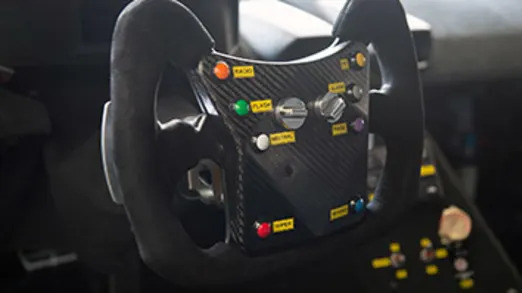
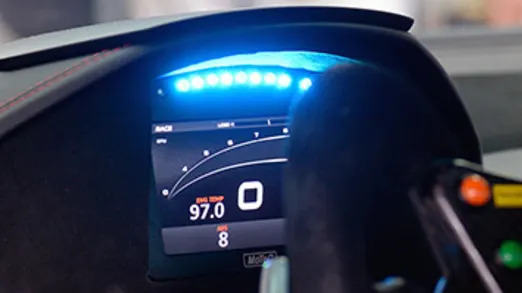

A good chunk of that weight loss comes from the removal of the entire front end of the drivetrain, which transforms this Huracán from an all-wheel-drive animal to a rear-drive beast. The cabin gains a roll cage and loses virtually all resemblance to the production car: in place of many of the Audi-derived creature comforts are expanses of bare metal and functional bits like a carbon fiber steering wheel, a Motec C185 display screen, and a single OMP racing seat. Upgraded Öhlins suspension components have been dialed in with different spring and damper rates, while the seven-speed dual-clutch transmission has been replaced with a sequential six-speed gearbox from Xtrac.
As you'd expect from a dedicated track toy, the Huracán Super Trofeo outwardly looks the part with lightweight body panels held down by Dzus fasteners, peekaboo-ing just the right amounts of mechanical hardware beneath. There's also extensive hardware for aerodynamic downforce, extraction, and redistribution of air, from the front flics to the massive hood nostrils to the tail diffuser, which reveals a chunky rear differential. Forget the boy racer accessories you'd find on most street cars: everything here serves a purpose-built function in the interest of going faster, better – from the massive air intakes at the nose to the park bench-size rear spoiler.
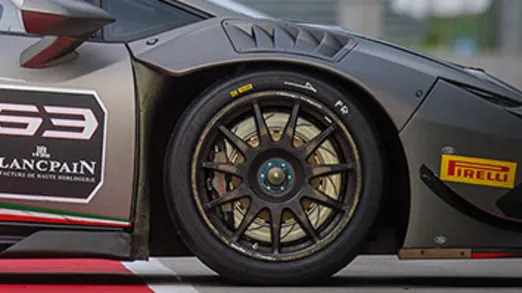

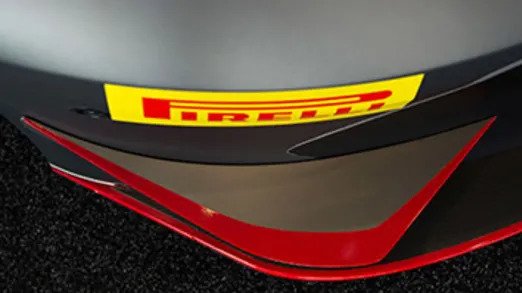
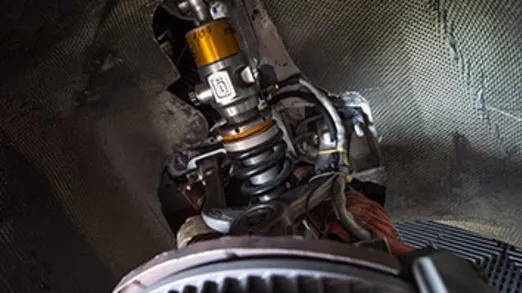
Uncorking The Bull
Climb into the Huracán LP 620-2 Super Trofeo, and prepare to forget everything you thought you knew about sports cars. Sure, there's a steering wheel at hand and three pedals at your feet. But since that wheel is clad with 10 cryptic, colorful buttons and the clutch pedal only gets you into first gear, there's a bit of a learning curve when it comes to piloting this particular specimen.
Click the door and swing it gently open (you wouldn't want to break it; the thing's deceptively light), and it takes a bit of a limbo dance to shimmy into the deeply sculpted seat. Because track time at the Malaysian Sepang F1 circuit is limited, we don't mind being cinched into the five-point harness by the support crew, which turns out to be an exercise in constraint and near-inappropriate physical contact.
Next up: Press the ignition button, then hold the starter button until the 10-cylinder fires to life with a whir and a roar. When you're ready to roll, hold the white "neutral" button while you push the clutch pedal and give a firm grab to the upshift paddle, which crunches the transmission into gear. Gradually let the clutch pedal out and you're moving, the engine resonance revealing a far louder, rougher exhaust note than the production car – which seems pretty damn refined compared to this cantankerous bad boy.
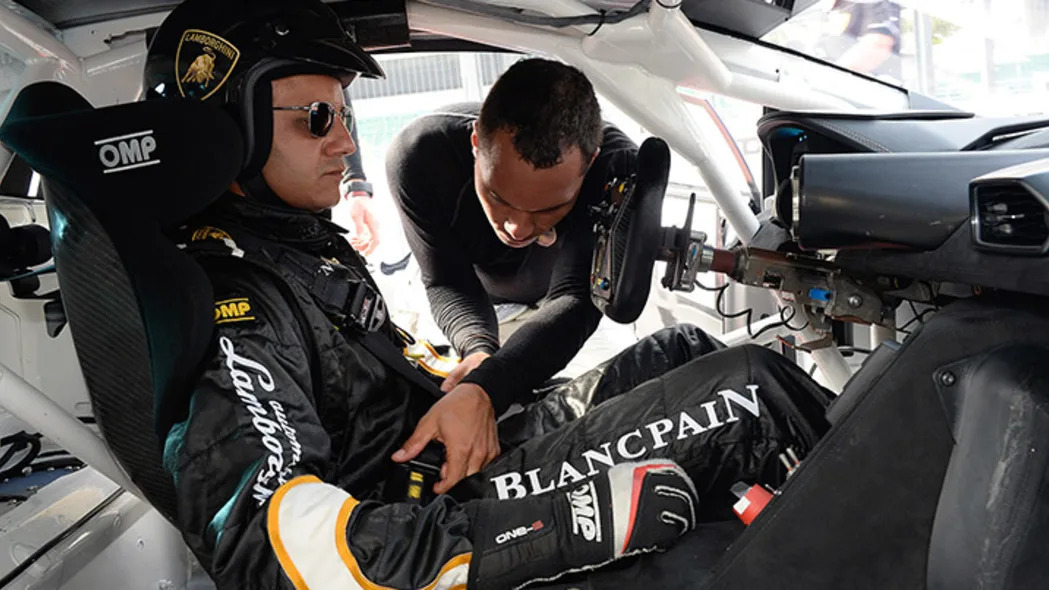
It's surprisingly difficult to maintain a constant, pit lane-legal velocity with the hair trigger throttle, and thus the perfect time to tap the "Pit" button which limits speed to 60 kilometers per hour (or 37 mph). The downside (or upside, depending on how your brain works) is the popcorn-like prattle of ignition retardation, which makes the V10 sound like it could blow at any minute. After traversing the length of pit lane and spotting a wave of the green flag, another tap of the Pit button unleashes the engine's pent-up energy that slams you into the seat, lurches the Lambo ahead, and fills the cabin with a glorious, voluptuous, mechanical bellow.
Unlike the production car's fairly sensitive paddles, the Super Trofeo demands a purposeful tug of the shifter, coaxing a crisp, near-instantaneous gear change from the sequential transmission. In concert with the tachometer lights (which climb in a green/blue/red ascension indicating the last few thousand engine revs), the interplay between the high-revving powerplant and its ornery, urgent gearbox requires quick reflexes and a vigilant eye on the tach.
Sepang's first corner demands a complete recalibration of the kinesthetic input required by brakes, steering, and throttle. Because middle-pedal effort is considerably higher (due to the removal of the production car's brake booster), it takes a heavy stab to slow the car down. But when the binders grab and deceleration kicks in, a shocking amount of negative Gs throw your body forward without any hint of ABS intervention. The first time you slow this racecar down, you realize you could have done so far, far later than you did – which is both a startling and, eventually, emboldening realization.

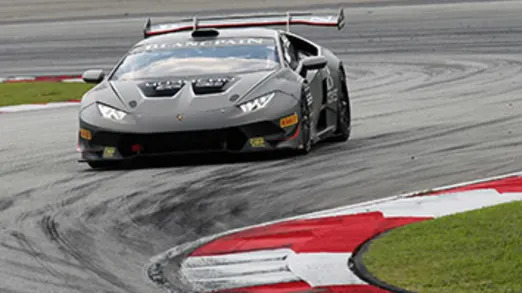
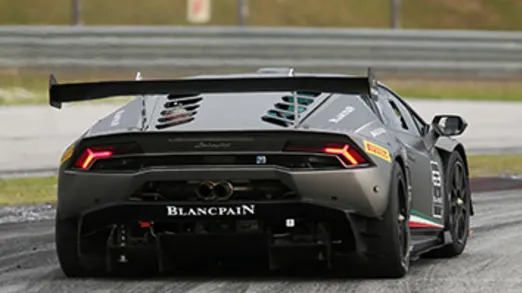

With a hydraulic steering rack replacing the standard Huracán's electromechanical arrangement, there's a more palpable, organic feeling to the way the tarmac surfaces are communicated. It becomes evident upon turn-in at your first (invariably slow-ish) corner that there is some tire slip, a bit of discernible understeer followed by oversteer, with a clear visitation of weight transfer in between. The car's dynamics register clearly through the wheel; that unfiltered flow of information is also delivered through the seat, conveying precisely how the four Pirelli contact patches are gripping – or sliding – with pavement, in part due to the car's 46-percent greater torsional stiffness.
A curious thing happens when you achieve higher corner speeds in the Super Trofeo. Thanks to the ability to deliver more than double the downforce of its roadgoing counterpart (along with sticky slicks), the racecar manages to grip pavement with incredible tenacity at higher speeds. On some of Sepang's corners it feels like the driver can do no wrong; the thing simply has miles of grip at hand. Without the downforce, running flat-out at higher speeds would be impossible given the amounts of power routed to the rear wheels. But with this miracle of windflow occurring around you and pushing the car down, it's possible to hurdle the Huracán into high-speed corners with abandon and pull out of them like it was wielding all-wheel drive and super glue tires.
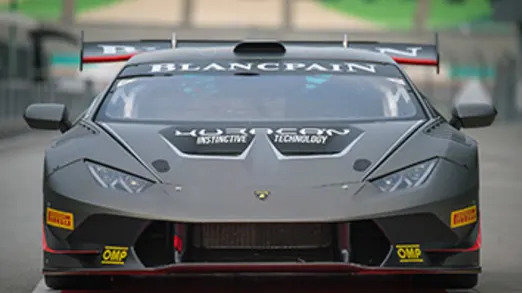
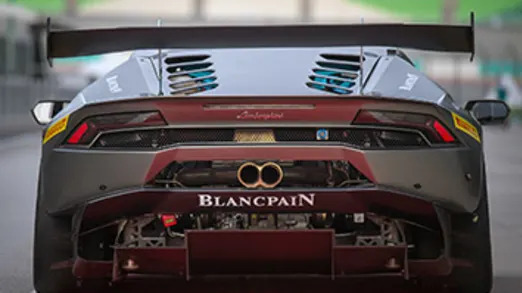
When you finally acclimate to the Super Trofeo's higher limits, it becomes easier to play with adhesion at lower speed corners. Hit the throttle early, and the tail kicks out; countersteer quick enough, and you can catch it and drift for a quick moment before correcting and straightening out. It requires razor-fast reflexes to pull off, but when executed just right, the reward is a rip-roaring blast. There's a small degree of traction control that can kick in at lower speed corners, but no so much that it gives you a false sense of confidence – and believe me, we have the spinout to prove it.
After several sessions behind the wheel of the Super Trofeo, the incredible potential of the Huracán is revealed in lurid detail, showing the extent of how far the Italian brand can push its already pungent two-seater. Yet while every component seems to operate perfectly when the car is driven like a bat out of hell, slower speeds reveal the rough edges of such focused machinery. During low-speed laps for photography, we tried maintaining a four- to five-foot gap from the camera car ahead. Though we tried to modulate the throttle with a delicate pedal foot, the car lurched and retreated rhythmically, undecided on whether to charge ahead or lay back. Similarly, the grabbiness of the brakes didn't become apparent until we tried working them at slower speeds, which quickly became an exercise of squeaky, disconcerting frustration. This baby is born to run, and it will simply kick sand in your face if you drive it at less-than-all-out speeds.
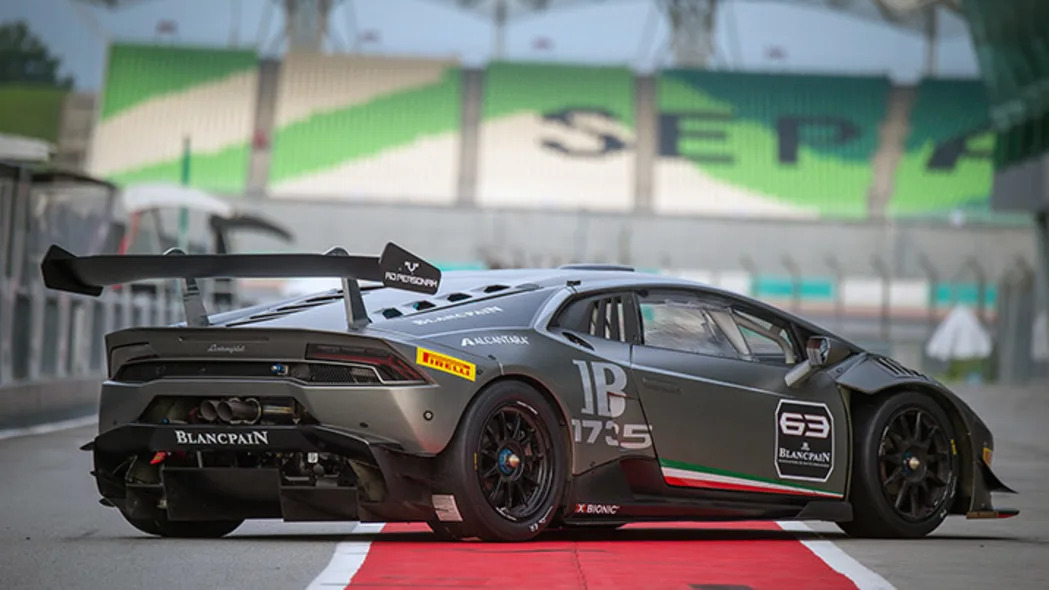
Bringing It Home
There's a "super" in supercar for a reason: exotics inspire the imagination with their outlandish forms and extreme performance, reaching far beyond the bounds of more attainable sports cars. And then there are racecars, which remove all pretense and focus like a laser on producing optimally efficient, expedient lap times.
Though its chassis is not as thoroughly reworked as Lamborghini's FIA-regulated GT3 racecar, the Super Trofeo is actually capable of producing similar lap times since it's not subject to the GT3's horsepower limitations, which peg output to the mid-500-hp range.
For $325,000 and a $45,000 entry fee, you can campaign this racecar in Lamborghini's one-make Blancpain Super Trofeo Series, which is essentially a gentleman's league that many consider to be a feeder program for GT3 racing. The dollars are serious – the entry fee covers three sets of race tires per weekend, but does not include food, lodging, transportation costs, maintenance, or fuel for your troubles. But perhaps race-prepped Huracáns can deliver more than just credibility to Lamborghini. If their tech trickles down to create lighter, more powerful, and meaner street cars, they will have done the Italian carmaker an equally magnanimous service.
Related Video:
Why compare the Raging Bull with the Prancing Horse in particular? Surely, any self-respecting gearhead knows that the two brands exude subtly different swaggers. But the gap goes well beyond the superficial: while Ferrari (not to mention competitors like McLaren and Porsche) has nurtured an enviable racing history from LeMans to Monaco, Lamborghini's history on the track is a bit scarcer. The Volkswagen Group recently thrust Bentley back into competition to reinvigorate the brand's past glories, and the next VW brand to win the racing lottery is Lamborghini.
Behold: the Lamborghini Huracán LP 620-2 Super Trofeo.
Born To Race
While Lamborghini claims a long history of wedge-shaped exotica, the Huracán was the first production car in the brand's half-century history to be engineered from scratch with the racetrack in mind. As such, the street car's screaming, naturally-aspirated V10 and 3,135-pound curb weight are mere starting points for Dallara Automobili, the firm tasked with developing the racecar in conjunction with Lamborghini.
For starters, the standard Huracán is alleviated of many of its pedestrian trappings like airbags, sound systems, and swanky power-operated leather seats. By jettisoning the unnecessary, the Super Trofeo manages to slim down nearly 330 pounds, to around 2,800 pounds. Don't let the mere 10 (metric) horsepower jump fool you: the LP 620-2's Motec engine management system not only adds data acquisition capabilities (which work alongside an eight-setting traction control system and a 12-setting Bosch ABS setup), it completely changes the power delivery characteristics of that 5.2-liter V10. More on that later.




A good chunk of that weight loss comes from the removal of the entire front end of the drivetrain, which transforms this Huracán from an all-wheel-drive animal to a rear-drive beast. The cabin gains a roll cage and loses virtually all resemblance to the production car: in place of many of the Audi-derived creature comforts are expanses of bare metal and functional bits like a carbon fiber steering wheel, a Motec C185 display screen, and a single OMP racing seat. Upgraded Öhlins suspension components have been dialed in with different spring and damper rates, while the seven-speed dual-clutch transmission has been replaced with a sequential six-speed gearbox from Xtrac.
As you'd expect from a dedicated track toy, the Huracán Super Trofeo outwardly looks the part with lightweight body panels held down by Dzus fasteners, peekaboo-ing just the right amounts of mechanical hardware beneath. There's also extensive hardware for aerodynamic downforce, extraction, and redistribution of air, from the front flics to the massive hood nostrils to the tail diffuser, which reveals a chunky rear differential. Forget the boy racer accessories you'd find on most street cars: everything here serves a purpose-built function in the interest of going faster, better – from the massive air intakes at the nose to the park bench-size rear spoiler.




Uncorking The Bull
Climb into the Huracán LP 620-2 Super Trofeo, and prepare to forget everything you thought you knew about sports cars. Sure, there's a steering wheel at hand and three pedals at your feet. But since that wheel is clad with 10 cryptic, colorful buttons and the clutch pedal only gets you into first gear, there's a bit of a learning curve when it comes to piloting this particular specimen.
Click the door and swing it gently open (you wouldn't want to break it; the thing's deceptively light), and it takes a bit of a limbo dance to shimmy into the deeply sculpted seat. Because track time at the Malaysian Sepang F1 circuit is limited, we don't mind being cinched into the five-point harness by the support crew, which turns out to be an exercise in constraint and near-inappropriate physical contact.
Next up: Press the ignition button, then hold the starter button until the 10-cylinder fires to life with a whir and a roar. When you're ready to roll, hold the white "neutral" button while you push the clutch pedal and give a firm grab to the upshift paddle, which crunches the transmission into gear. Gradually let the clutch pedal out and you're moving, the engine resonance revealing a far louder, rougher exhaust note than the production car – which seems pretty damn refined compared to this cantankerous bad boy.

It's surprisingly difficult to maintain a constant, pit lane-legal velocity with the hair trigger throttle, and thus the perfect time to tap the "Pit" button which limits speed to 60 kilometers per hour (or 37 mph). The downside (or upside, depending on how your brain works) is the popcorn-like prattle of ignition retardation, which makes the V10 sound like it could blow at any minute. After traversing the length of pit lane and spotting a wave of the green flag, another tap of the Pit button unleashes the engine's pent-up energy that slams you into the seat, lurches the Lambo ahead, and fills the cabin with a glorious, voluptuous, mechanical bellow.
Unlike the production car's fairly sensitive paddles, the Super Trofeo demands a purposeful tug of the shifter, coaxing a crisp, near-instantaneous gear change from the sequential transmission. In concert with the tachometer lights (which climb in a green/blue/red ascension indicating the last few thousand engine revs), the interplay between the high-revving powerplant and its ornery, urgent gearbox requires quick reflexes and a vigilant eye on the tach.
Sepang's first corner demands a complete recalibration of the kinesthetic input required by brakes, steering, and throttle. Because middle-pedal effort is considerably higher (due to the removal of the production car's brake booster), it takes a heavy stab to slow the car down. But when the binders grab and deceleration kicks in, a shocking amount of negative Gs throw your body forward without any hint of ABS intervention. The first time you slow this racecar down, you realize you could have done so far, far later than you did – which is both a startling and, eventually, emboldening realization.




With a hydraulic steering rack replacing the standard Huracán's electromechanical arrangement, there's a more palpable, organic feeling to the way the tarmac surfaces are communicated. It becomes evident upon turn-in at your first (invariably slow-ish) corner that there is some tire slip, a bit of discernible understeer followed by oversteer, with a clear visitation of weight transfer in between. The car's dynamics register clearly through the wheel; that unfiltered flow of information is also delivered through the seat, conveying precisely how the four Pirelli contact patches are gripping – or sliding – with pavement, in part due to the car's 46-percent greater torsional stiffness.
A curious thing happens when you achieve higher corner speeds in the Super Trofeo. Thanks to the ability to deliver more than double the downforce of its roadgoing counterpart (along with sticky slicks), the racecar manages to grip pavement with incredible tenacity at higher speeds. On some of Sepang's corners it feels like the driver can do no wrong; the thing simply has miles of grip at hand. Without the downforce, running flat-out at higher speeds would be impossible given the amounts of power routed to the rear wheels. But with this miracle of windflow occurring around you and pushing the car down, it's possible to hurdle the Huracán into high-speed corners with abandon and pull out of them like it was wielding all-wheel drive and super glue tires.


When you finally acclimate to the Super Trofeo's higher limits, it becomes easier to play with adhesion at lower speed corners. Hit the throttle early, and the tail kicks out; countersteer quick enough, and you can catch it and drift for a quick moment before correcting and straightening out. It requires razor-fast reflexes to pull off, but when executed just right, the reward is a rip-roaring blast. There's a small degree of traction control that can kick in at lower speed corners, but no so much that it gives you a false sense of confidence – and believe me, we have the spinout to prove it.
After several sessions behind the wheel of the Super Trofeo, the incredible potential of the Huracán is revealed in lurid detail, showing the extent of how far the Italian brand can push its already pungent two-seater. Yet while every component seems to operate perfectly when the car is driven like a bat out of hell, slower speeds reveal the rough edges of such focused machinery. During low-speed laps for photography, we tried maintaining a four- to five-foot gap from the camera car ahead. Though we tried to modulate the throttle with a delicate pedal foot, the car lurched and retreated rhythmically, undecided on whether to charge ahead or lay back. Similarly, the grabbiness of the brakes didn't become apparent until we tried working them at slower speeds, which quickly became an exercise of squeaky, disconcerting frustration. This baby is born to run, and it will simply kick sand in your face if you drive it at less-than-all-out speeds.

Bringing It Home
There's a "super" in supercar for a reason: exotics inspire the imagination with their outlandish forms and extreme performance, reaching far beyond the bounds of more attainable sports cars. And then there are racecars, which remove all pretense and focus like a laser on producing optimally efficient, expedient lap times.
Though its chassis is not as thoroughly reworked as Lamborghini's FIA-regulated GT3 racecar, the Super Trofeo is actually capable of producing similar lap times since it's not subject to the GT3's horsepower limitations, which peg output to the mid-500-hp range.
For $325,000 and a $45,000 entry fee, you can campaign this racecar in Lamborghini's one-make Blancpain Super Trofeo Series, which is essentially a gentleman's league that many consider to be a feeder program for GT3 racing. The dollars are serious – the entry fee covers three sets of race tires per weekend, but does not include food, lodging, transportation costs, maintenance, or fuel for your troubles. But perhaps race-prepped Huracáns can deliver more than just credibility to Lamborghini. If their tech trickles down to create lighter, more powerful, and meaner street cars, they will have done the Italian carmaker an equally magnanimous service.
Related Video:
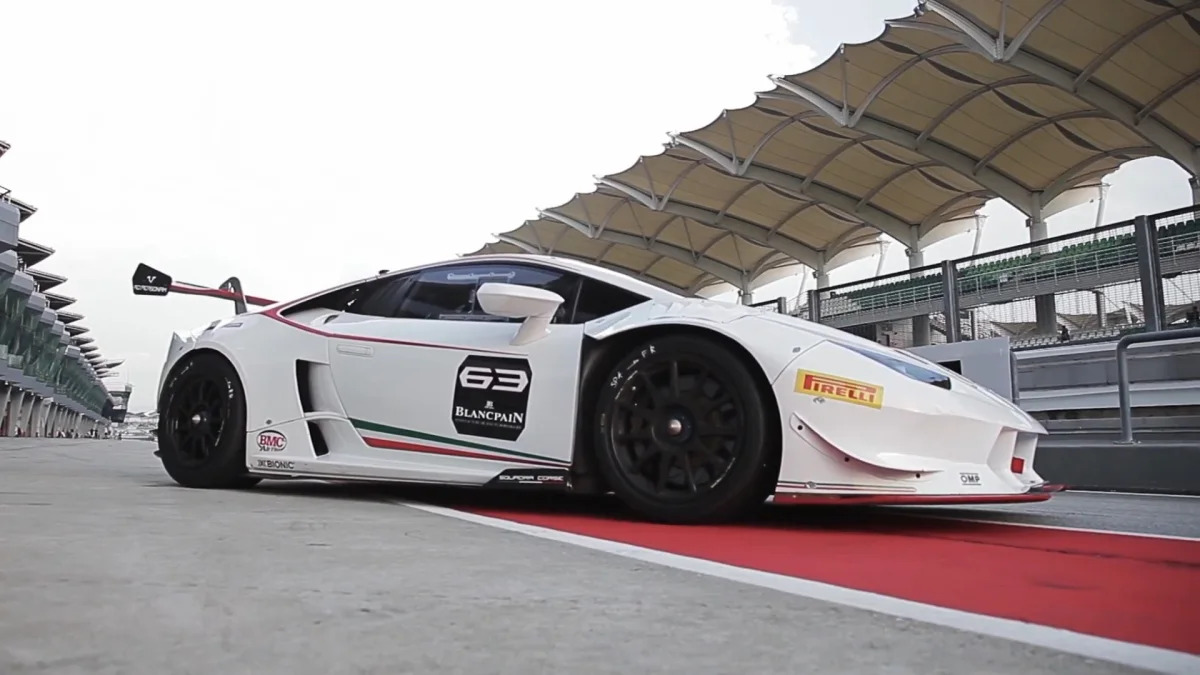









Sign in to post
Please sign in to leave a comment.
Continue